Document 12030364
advertisement
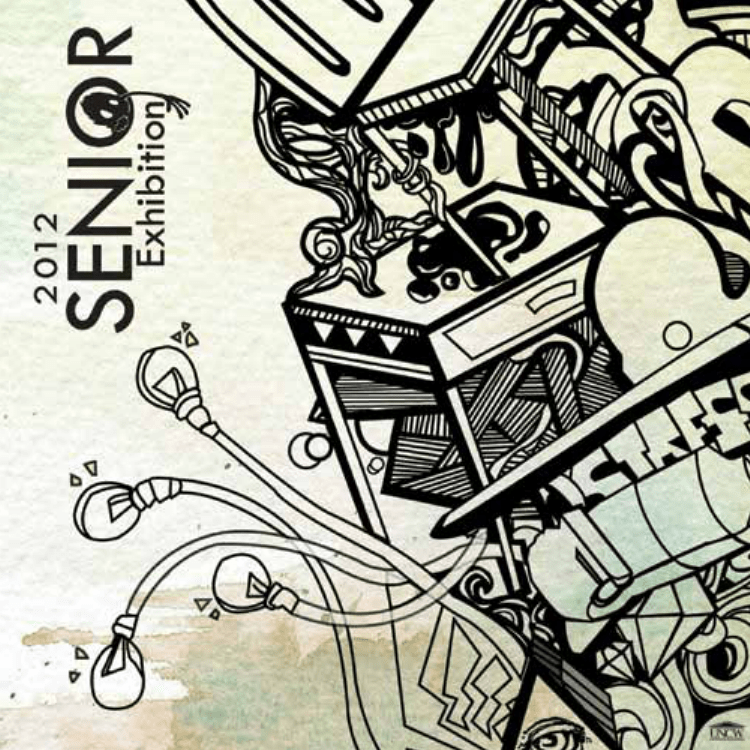
Zach Burkhart Laura Erickson Zachary Feutz Joshua Gomez Chad Harrell Katie Hare Sam Hilker Merryn Kepchar Elizabeth McAdams Brooks McGibbony Blair Nidds Anne Seay Stephanie Stull Ryan Daniel Terry Senior Exhibition Spring 2012 Zach Burkhart When taking photographs, I enjoy using extremely wide angle lenses to achieve views that are impossible to see with my eyes. I also employ shallow depth of field to my advantage, to separate my subject from the background, and draw the viewer’s eye to a specific place in the photograph. Laura Erickson My creative process has evolved through experimenting with bold colors, portraits; paint application, reduction and finally movement though pattern and layers. My inspiration is generated from geometric black and white patterns found in nature and textiles. I realized that I needed to allow my informal patterns to breathe and that it is necessary to have space in the composition to move in and out. By recovering with gesso and white paint, my work became more translucent and the viewer is able to move through the layers. By defining and mastering the intricate designs of pattern, I have found a new direction in my artistic focus. Replicating the pattern related elements of design I was able to identify the meanings enveloped in the canvas. My process began with structure and evolved into the meaning behind the breaking the structure. I intend to use my artistic skills and knowledge of textile-based artwork creatively in a textile design company. Zachary Feutz My ideas often come from mythological or folkloric imagery. Such ideas have enthralled the human mind since the dawn of existence and I believe that such archetypal visions allow a person to reflect their own personality and soul onto them. My choice in how I depict these themes draws from modern pop cultural art, such as comics and animation. Peoples of the past drew based on culture and what captivated them, and I seek to do the same. I assembled my visual vocabulary piecemeal, collecting small elements of what I admired from images around me. Comics are a visual medium and are one of the few that have obvious meaning for the viewer. I admire animation for the fluidity and efficiency of its design. I seek a simple, strong visual impact using imagery and stories that resonate with my audience. I invite the audience not only to interpret my vision, but to examine theirs as well. I want my art to be a mirror to the viewers own personal vision. Joshua Gomez My paintings are vessels that carry a message. I create vague narratives, hoping that they will engage the audience long enough to find purpose in the work. My final concerns are color and design. I decide what colors best relate to the story I tell, and compose the work in the most concise way that I can. I prefer bright colors because they are more stimulating and childlike, thus creating irony in their opposition to a more complex storyline. Chad Harrell I want to create dimensionality on the canvas by layering paint and stripping it away with knives. I create intuitively, with each piece interlocking to convey a whole idea. Katie Hare By combining the techniques of darkroom, digital photography, and paper cut-outs, I alter my photographs to resemble street art. My aim is to make people believe in the power of imagination and encourage them to view boring surfaces such as a brick wall or dilapidated building as a canvas for the impossible. Sam Hilker My goal in taking a photograph is to reflect as purely as possible what I see. I strive towards capturing a wide range of approaches when photographing outdoor landscapes and downtown urban life. Merryn Kepchar I often imagine ribbons moving through walls, ribbons that go from one room, one space through the walls into another room. The line moves through numerous spaces, some of them shallow, some expansive. The line might move up and down, taking longer to move through space, or it might be efficient and clean and go straight, taking less time and space. From this day dream, my paintings emerge out of the layering of spaces and planes. Building up from a gestural framework of directional lines, areas can push forward towards us through heavy layers that take on definition, while other areas remain less developed and recede. Working this way, the chance encounter of spaces can become the most interesting parts of the work. Elizabeth McAdams Growing up on a farm in Efland, NC, I developed an appreciation for nature and its inherent beauty which influences my art making process. Using the technique of frottage, I rub charcoal or graphite on paper or cloth pressed against a textured surface. I make rubbings of various materials like branches, leaves, seed pods, combined with manmade textures like yarn, wire, and other materials to create contrasting textures on fabric. This technique leaves a vague impression of the object on the cloth. Frottage allows me to use objects from nature directly, like leaves, to capture a beauty that would eventually decompose in nature. I use found materials such as old embroidery pieces, tablecloths, and old fabric as a ground for the rubbings and often sew fabric on as well. These found discarded objects connect me with the past and I am able to conceive a new life to a once functional and appreciated piece of art. Brooks McGibbony My inspirations usually come from the world around me; nature, a skyscraper in a large city, a bird landing ten feet from where I am walking, and the moon hanging high in the sky are a few examples. Although I prefer realism, I have begun to shift towards abstraction. This is apparent in one of my most recent land art projects known as “Overlapping Sand”, inspired by Andy Goldsworthy. For this artwork I traveled to North Topsail Beach, North Carolina. Creating land art can be challenging because there are many factors that can affect the outcome; weather, time of day, and location are just a few of the variables involved in the planning process. The materials I used in nature were the sand on the beach and shells that had been washed ashore by the morning tide. I began by drawing the design of the area I was considering to work in. My design was then constructed using my hands as my tools. As the viewer walks along the beach, he will be surprised when he realizes the seemingly natural design undulating in the sand is actually man-made; not created by wind or water. Blair Nidds My landscape paintings are derived from instinct and imagination. I paint aerial and elemental landscapes that possess visual and physical texture through materials such as spackling, crackle paste, gel medium, acrylic wash, and charcoal. I begin with the motif of an island-like aerial map composition—a pattern that comes from an interest in topographical diagrams as well as elevation views of terrain. I apply several layers of acrylic washes and overlay coats of modeling paste and pumice gel medium to suggest varying levels of depth, and then add paint to the difference between the washes and pastes, providing a smooth transition between the textures. My palette consists of earthy colors such as red oxide, raw sienna, sap green, and burnt umber to convey a sense of land, water, and sky. Land composed of rigid mountains, water-buried coastlines, or cloud-covered farmlands evoke a personal emotional response, and are what I strive to translate through paint. Anne Seay I hope for my paintings to invoke a deep range of emotions within the viewer. My work begins with an idea, an image of a past life, which hopefully can invoke a range of feelings within my viewers and still leave room for mystery. The finished product is usually a mix of chance, intuition and opportunity. The collage paintings are surreal and somewhat abstract because of the unusual juxtaposition of images. Furthermore, there is no discernible narrative or story line of any kind behind them; I prefer that the meaning of my paintings be determined within the mind of each viewer. The figures appear like apparitions as if in a dream and the compositions are often permeated with an eerie atmosphere not intended at the beginning. I use images found from everyday life. The images I find normally have a historic or antique feel about them. I assemble them intuitively. The editing processes begin; images come and go. Stephanie Stull Clean brushes, new tubes of acrylic paint, fresh water, and a blank canvas challenge me; “What do you see?” My inner vision imposes an endless world shaped by texture and color on a bare, flat surface. Washed over, pushed back, pulled forward, tucked behind, placed between, scraped out, wiped away, and painted back again the work evolves. Working quickly, large palette knife in hand, I apply thick textured sections of modeling paste. The texture adds natural shadow, dimension, and drama even before I apply the acrylic paint. My work is composed of flowing amoebic forms, spheres, and usually a recognizable object. The canvas, a desolate empty space, morphs into domain where my dreams live. It is a world created by pure emotion, curiosity, and uncertainty. And somehow, this yields the truest recollection of my life experiences. Ryan Daniel Terry Practicing ceramics is the gift of turning coal into diamonds. The clay tells me what it wants to be and I reply with a language that my hands provide. I draw on a tradition of American styles like the recognizable forms of Seagrove potters but I am pushing the clay in a contemporary, sculptural direction while preserving its organic expression. The Department of Art and Art History offers majors in art history and studio art which prepare students for advanced study in their chosen field. UNCW DEPARTMENT OF ART & ART HISTORY
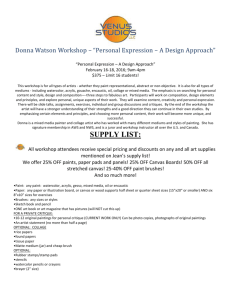
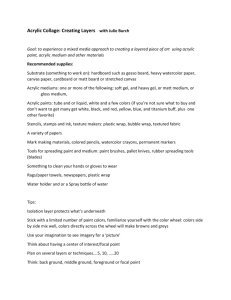
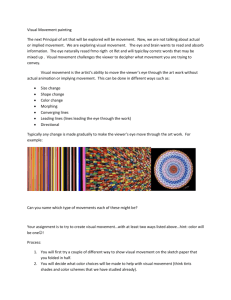

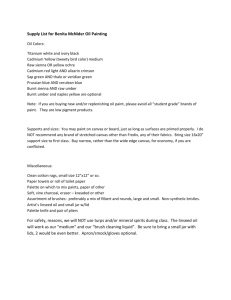

![[Agency] recognizes the hazards of lead](http://s3.studylib.net/store/data/007301017_1-adfa0391c2b089b3fd379ee34c4ce940-300x300.png)

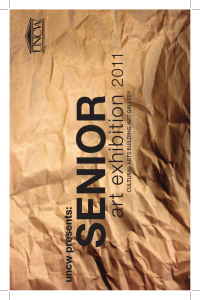
![2014 [ ] ROBERT JINKINS PURF](http://s2.studylib.net/store/data/017827386_1-a3c981e915d0c2baed02dce0129102b0-300x300.png)